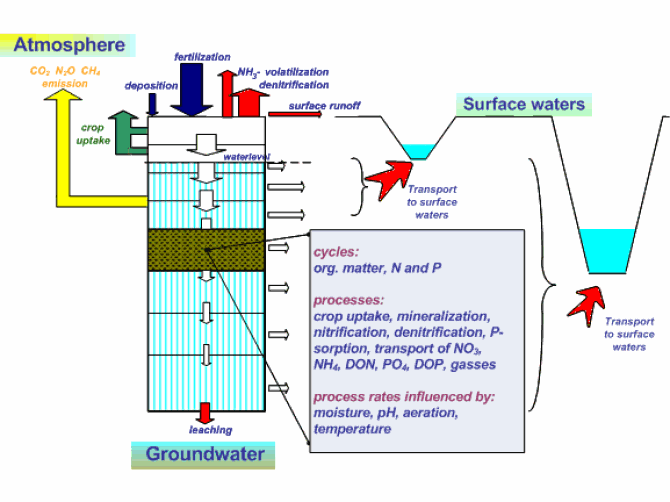Description ANIMO model
The ANIMO model simulates the transport of nutrients to groundwater and surface water systems and the emission of green house gasses for a wide range of soil types, land management practices and hydrological conditions.
Nutrient losses from land to surface waters
Transport routes from soils to groundwater and surface water systems and the atmosphere are schematically depicted in Figure 1.

ANIMO comprises description of the organic matter cycle, the nitrogen cycle and the phosphorus cycle since these cycles are interrelated in most of the modern farming systems and in soil bio-chemistry. The model focuses on the following processes:
- Inputs or additions to the soil system (fertiliser, manure, crop residues, atmospheric deposition);
- mineralization of nutrient compounds in relation to formation and decomposition of different types of organic matter as organic fertilisers, root residues, yield losses and native soil organic matter;
- NH3-volatilisation and emission to the atmosphere;
- nitrification of NH4 and denitrification of NO3;
- sorption onto and diffusion within soil particles, described by a combination of instantaneous and time dependent sorption and chemical precipitation of phosphates (Schoumans and Groenendijk, 2000);
- uptake by the vegetation;
- transport of dissolved organic and inorganic nutrients with water flow to deeper soil layers and to adjacent surface water systems;
- overland flow of particulate and dissolved organic phosphorous and inorganic phosphate with water flow to adjacent fields (runoff and erosion);
- a new feature includes the simulation of nutrient transport in cracking clay soils and macro-porous peat soils and the emission of green house gasses (CO2, N2O, CH4) (slide show)
Hydrological input data concerning soil moisture contents and water fluxes are derived from the output of supporting hydrological models. The SWAP model is mostly used to generate this type of input. The spatial discretization of the supporting hydrological model should be attuned to the division of soil layers in the ANIMO model.
The model has three options to simulate nitrogen and phosphorous uptake by crops and natural vegetations. One of the options is to impose pre-calculated crop uptake rates per time step. For this purpose, the results of the QUADMOD model can be used.
Model Specification
Rate variables:
oxygen demand, exudate production, decomposition rates of four types of organic matter, nitrification rate, sorption rates for ammonium and phosphorus, fourteen water fluxes (precipitation, runoff, seepage, leaching, first-, second- and third-order drainage and infiltration, three evaporation terms, transpiration)
Number of rate variables:
about 50
State variables:
moisture contents, quantities of exudates, humus, fresh and soluble organic matter, adsorbed ammonium and phosphorus, nitrate, ammonium and phosphate in soil solution
Number of state variables:
over 75
Input data:
Soil moisture contents and water fluxes per simulation time step, fertilizer management (rate, type of fertilizer, time and depth of application), soil physical properties (pF, bulk density, five temperature parameters, oxygen diffusion coefficients in soil), soil chemical properties (pH, sorption coefficients, sorption rates), boundary and initial conditions
Number of input data:
about 80
Output data:
time series per compartment for nitrate-N, ammonium-N, DON, ortho-P, DOP concentrations, balance sheets for water, nitrogen and phosphorus for user defined units of soil depth
Number of output data:
variable (over 1000)
Time increments:
Simulation time step: 1-10 days. Output time step: 1 day - 1 year
Basic unit of surface area:
1 m2 (lysimeter) - 1000 ha (plot in regional model)
Technical specifications
Hardware:
IBM-compatibles with coprocessor
Programming language:
FORTRAN 77/90
Other software requirements:
none
User's guide and technical reference:
Renaud, L.V., J. Roelsma and P. Groenendijk, 2005. User’s guide of the ANIMO4.0 nutrient leaching model. Wageningen, Alterra–Report 224, 184 pp
Application reports:
list of some applications on local and regional scales is included in the User's Guide.
Source code available:
in principle no (exceptions can be made for PhD-research, please contact Alterra)
Executable available:
yes, upon request
